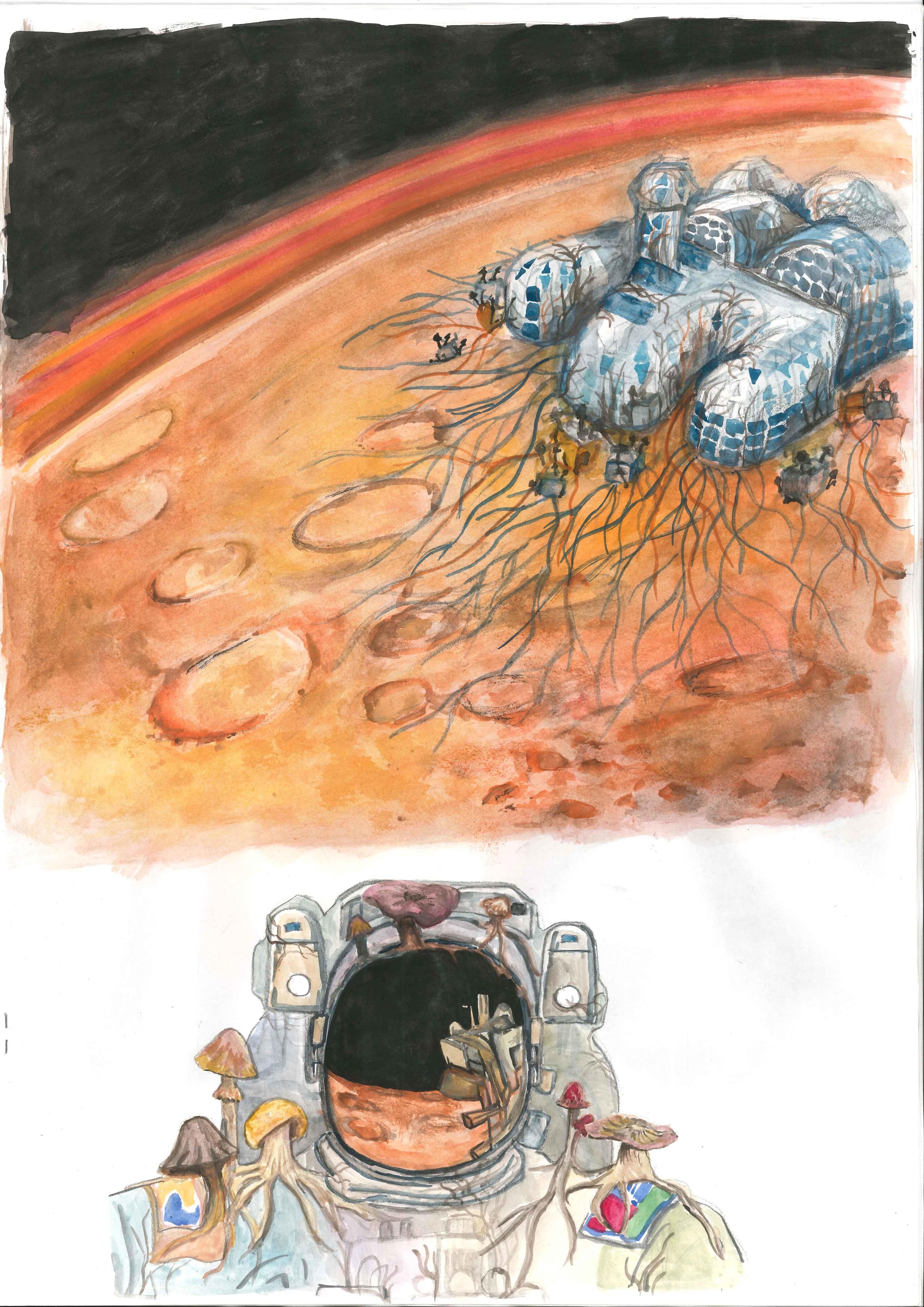
5 minute read
Interstellar Architecture
Interstellar
Advertisement
Who hasn’t dreamt of going to space, at least once? The idea of venturing to distant planets,constructing new habitats, and going where no man has gone before appeals deeply to the human spirit that has sent us to every corner of the earth. Since the fervour of the space race in the late 1960s, science-fction has been omnipresent in entertainment, every year seeing more fantastic alien planets and imaginative new technologies take over our screens. The way these shows imagine the human habitats of the future, however, seems to vary little. It’s normally an environment dominated by cold steel and thick glass; an utterly artifcial space punctuated by fashing lights and lens fares, with the only life on-screen being our heroes and whichever alien is eating the maintenance crew that week.
So, it may come as some surprise that for NASA, the building material to create their lunar and Mars bases is entirely organic, and yet, appropriately, like nothing we use on Earth: fungi; specifcally, the mat of long, fbrous threads that fungi produce to feed, known together as the mycelium. The use of fungi to create habitats has been dubbed “myco-architecture”, and on Mars, biomaterials could be used to their fullest to conquer the hostile fnal frontier. Through clever genetic engineering and careful use of Mars’ few resources, the frst men and women on Mars may end up being sheltered and provided for by a habitat built, in part, from this unlikely material. Designing a habitat suitable for a permanent base on Mars is one of the major challenges for astronauts and engineers to overcome. As one of NASA’s Centennial Challenges, over two million dollars has been awarded in prizes for innovations in the feld. This is not an easy task; these bases must fulfl a variety of very specifc design criteria, as outlined under NASA’s various DRA (Design Reference Architecture) scenarios. They must be lightweight and greatly expandable to save crucial space on the shuttle, and able to withstand the harsh Martian e n v i r o n m e n t once deployed; an incredibly thin atmosphere with no ozone layer means the surface is constantly bombarded with radiation, and temperatures can fuctuate by close to a hundred degrees – these conditions cause most of our plastics and metals to degrade, and even begin to produce toxic gases. G iven the apparent horror of the
Martian surface, where even some of the toughest materials we have today fail, it is hard to imagine how something as insignifcant as a fungus could be much help. Yet researchers at the Ames Research Centre, led by astrobiologist Lynn Rothschild, believe that biological building materials ofer a solution to every one of the red planet’s many challenges. For a start, years of testing have shown that, used correctly, mycelium is comparable to wood or concrete in resisting deformation under pressure, and matches both in insulating properties.
However, fungi can do far more than just match conventional building materials. As living things, fungi are naturally self-expanding and self-repairing. A small starter sample could be stored and transported to Mars, and then activated by astronauts with provided nutrients, and allowed to grow. With the provision of a lightweight plastic framework, a thick layer of mycelium would grow and shape to form a liveable habitat. However, the greatest strength of myco-architecture comes from the versatility of living organisms. Using extensive genetic engineering, the fungi can also be radically altered to allow them to support the structure and its occupants. Back on Earth, fungi feed by excreting enzymes from the threads in their mycelium, individually called hyphae, into the environment. A feld of biology known as “synthetic biology” looks to instead change the fungi to secrete products useful for Mars exploration.
This could include agglutinating agents to better seal the mycelium against the elements or melanin for soaking damaging radiation (the same compound that protects human skin from UV rays). Rothschild envisions the complete biological Martian habitats taking on a three-layered structure. The frst, outermost layer would be frozen water, which we now know is plentiful at the Martian poles, and which already has signifcant radiation-absorbing properties. Some of this water would be allowed to trickle into the second layer, built of bacterial cultures. Some bacteria, called cyanobacteria, are capable of using

water and carbon dioxide to produce oxygen by a process analogous to plant photosynthesis, which is essential to sustain both the humans and the third, most substantial layer, where the fungi act to seal the habitat; water accumulating there, reinforced with regolith (the geological term for the “dust” found on the surface of Mars and the Moon) and high levels of lead particles thought to be present on Mars, will create a radiation-proof, airtight shield to shelter astronauts from the Martian climate. Finally, once the already long-lived fungi have broken down, the remains can be readily used as compost to support extraterrestrial farming - myco-architecture represents the ultimate goal in sustainability, where every part can be used, and then broken down and recycled. U ltimately, it seems the only limits with myco-architecture are the gaps in our knowledge, and our imaginations. Beyond just providing a lightweight, low-cost building material (already a pretty good feature!), fungi could be engineered to grow into furniture, to flter waste, even to glow and illuminate Mars bases and, perhaps one day, our homes. While for now this research is focused on taming Mars, and still in its very early stages, the knowledge gained from these missions could allow myco-architecture to see widespread use on Earth too. Though the future is always uncertain, it appears that the wonderful versatility of nature may dominate the course of human spacefight, and in time, a greener life on Earth too. James Rainey is a Biological Sciences undergraduate at Magdalen College.









